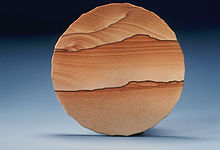
Back Sandsteen Afrikaans Piedra d'arena AN बलुआ पत्थर ANP حجر رملي Arabic Gres AST Sandstoa BAR Пясчанік Byelorussian Пяшчанік BE-X-OLD Пясъчник Bulgarian Gres Catalan
| Sedimentary rock | |
 Cut slab of sandstone | |
| Composition | |
|---|---|
| Typically quartz and feldspar; lithic fragments are also common. Other minerals may be found in particularly mature sandstone. |
Sandstone is a clastic sedimentary rock composed mainly of sand-sized (0.0625 to 2 mm) silicate grains, cemented together by another mineral. Sandstones comprise about 20–25% of all sedimentary rocks.[1]
Most sandstone is composed of quartz or feldspar, because they are the most resistant minerals to the weathering processes at the Earth's surface. Like uncemented sand, sandstone may be imparted any color by impurities within the minerals, but the most common colors are tan, brown, yellow, red, grey, pink, white, and black. Because sandstone beds can form highly visible cliffs and other topographic features, certain colors of sandstone have become strongly identified with certain regions, such as the red rock deserts of Arches National Park and other areas of the American Southwest.
Rock formations composed of sandstone usually allow the percolation of water and other fluids and are porous enough to store large quantities, making them valuable aquifers and petroleum reservoirs.[2][3]
Quartz-bearing sandstone can be changed into quartzite through metamorphism, usually related to tectonic compression within orogenic belts.[4][5]
- ^ Boggs, Sam (2006). Principles of sedimentology and stratigraphy (4th ed.). Upper Saddle River, N.J.: Pearson Prentice Hall. pp. 119–135. ISBN 0131547283.
- ^ Swanson, Susan K.; Bahr, Jean M.; Bradbury, Kenneth R.; Anderson, Kristin M. (February 2006). "Evidence for preferential flow through sandstone aquifers in Southern Wisconsin". Sedimentary Geology. 184 (3–4): 331–342. Bibcode:2006SedG..184..331S. doi:10.1016/j.sedgeo.2005.11.008.
- ^ Bjørlykke, Knut; Jahren, Jens (2010). "Sandstones and Sandstone Reservoirs". Petroleum Geoscience. pp. 113–140. doi:10.1007/978-3-642-02332-3_4. ISBN 978-3-642-02331-6.
- ^ Cite error: The named reference
EGwas invoked but never defined (see the help page). - ^ Powell, Darryl. "Quartzite". Mineral Information Institute. Archived from the original on 2009-03-02. Retrieved 2009-09-09.